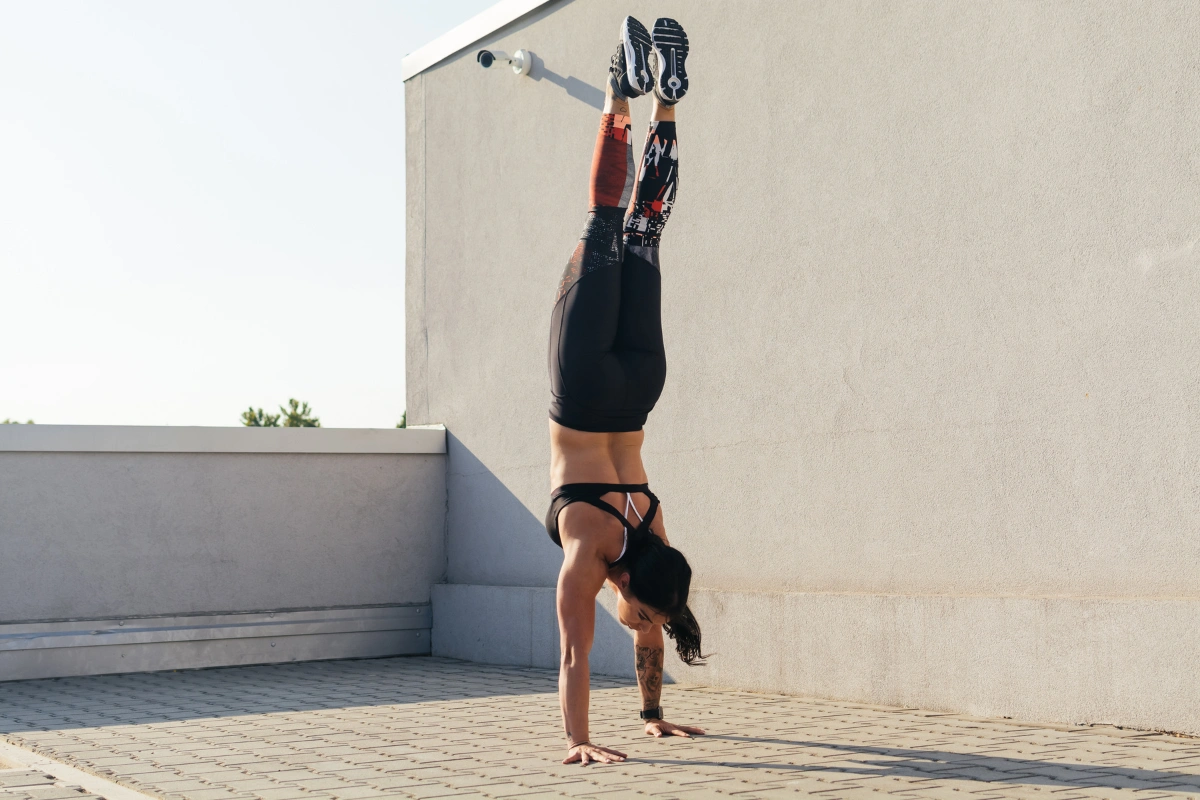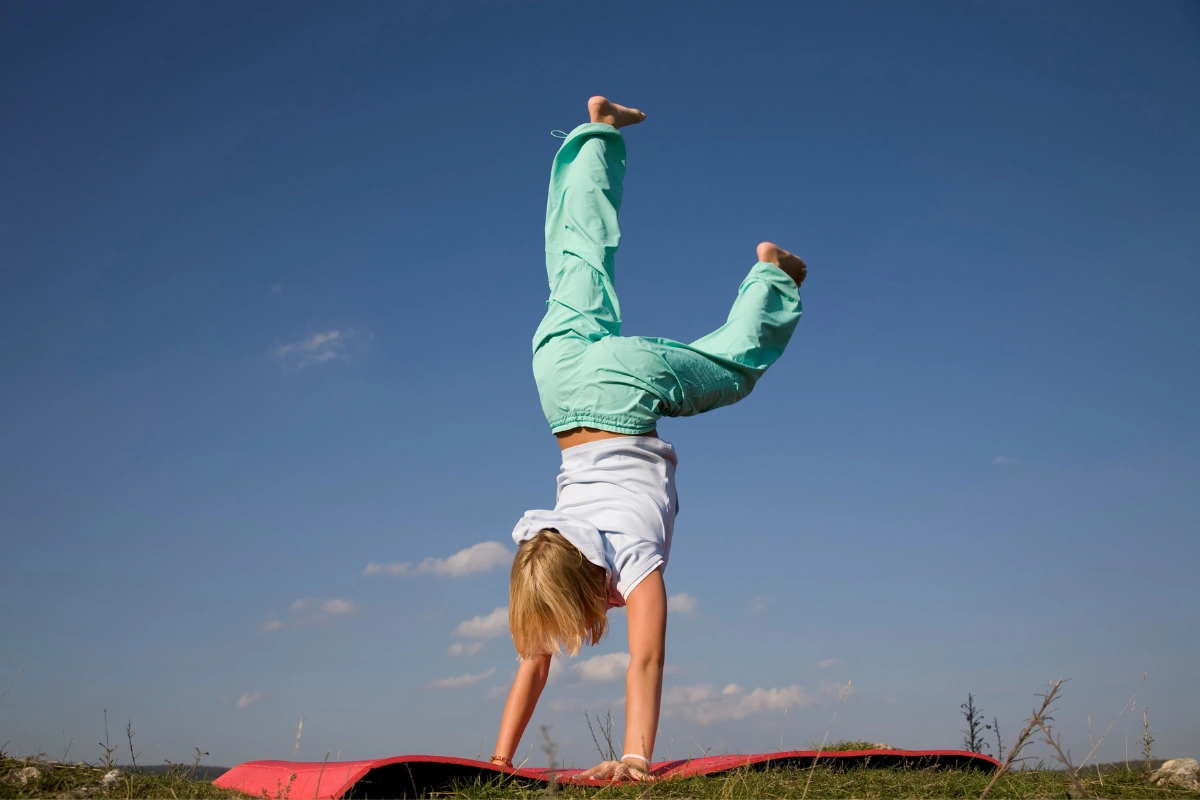Hand balancing, often referred to as handstands, is a captivating art form and physical discipline that has captivated practitioners for centuries. Rooted in gymnastics, acrobatics, and yoga, hand balancing involves the mastery of inverted body positions, relying on the hands and arms as primary support. Beyond its aesthetic appeal, hand balancing offers a myriad of benefits for both body and mind. In this post, we delve into the intricacies of hand balancing, exploring its techniques, variations, and the multitude of advantages it brings to those who incorporate it into their fitness routines. Join us as we uncover the wonders of hand balancing and discover the numerous pros that come with mastering this captivating skill.
What is Hand Balancing?
Hand balancing, also known as handstands, encompasses the skillful art and disciplined practice of maintaining an inverted body position primarily using the hands and arms for support. The handstand position itself offers a multitude of variations, ranging from the basic tuck, pike, and straddle leg positions to the more intricate and demanding one-arm hold.
Performing handstands can take place on various surfaces including the floor, canes, blocks, or even more creatively designed structures. It serves as both an individual training exercise and as an integral component within partner or group acrobatic routines.
Recognized for its efficacy and versatility, the handstand stands as one of the most beneficial training exercises across diverse disciplines. Executed with proper technique, it engages the shoulder girdle, arms, and core muscles, fostering enhanced movement coordination, balance, and heightened blood circulation to the brain.
Moreover, the handstand finds application in a plethora of sports and physical activities, including but not limited to power gymnastics, acrobatic dancing, break dancing, street workout, cheerleading, and yoga. Its incorporation into such practices underscores its significance as a foundational element in fostering strength, agility, and overall physical prowess.

What are the pros of doing Handstand?
Make arms and shoulders stronger
Engaging in handstands offers a myriad of advantages that extend beyond mere physical strength. Firstly, this exercise significantly strengthens the muscles of the arms and shoulders. Even just a few minutes of consistent practice can yield noticeable results, making it an accessible and efficient means of building upper body strength without the need for specialized equipment or heavy weights. This makes handstands an ideal option for individuals seeking to enhance their muscular endurance and overall physical fitness from the comfort of their own home.
Furthermore, the practice of handstands boasts benefits for the endocrine system. When assuming the inverted position, blood flow to the head is augmented, facilitating the production and assimilation of hormones such as T3 and T4. These hormones play a crucial role in metabolism regulation, thereby promoting efficient fat burning within the body. Moreover, the secretion of cortisol, a stress hormone notorious for its adverse effects on health, is mitigated during handstands, leading to a reduction in its overall production. This hormonal balance not only contributes to improved physical well-being but also fosters a sense of mental clarity and relaxation.
Saturate bone tissue with calcium
Regular exercise plays a pivotal role in maintaining optimal bone health by promoting the saturation of bone tissue with essential minerals, particularly calcium. When it comes to the practice of handstands, the inversion of the body’s typical orientation serves to redefine the distribution of load along the spine. By inverting the body, handstands effectively target and strengthen areas of the spine that may not be adequately engaged through conventional exercises, thereby promoting spinal health and resilience.
Moreover, engaging in handstands fosters improvements in spatial perception, a cognitive skill essential for navigating and interacting with the surrounding environment. The dynamic nature of handstand training challenges the brain to adapt and refine its spatial awareness, honing its ability to accurately interpret and respond to spatial cues. This cognitive stimulation not only enhances one’s ability to maintain balance and stability during handstands but also translates to enhanced spatial cognition in everyday activities.

Balance the hormones
Handstands play a pivotal role in hormonal regulation, operating through a complex interplay between body positioning and the function of the pituitary gland. Situated at the base of the brain, the pituitary gland serves as a central hub for hormone production, exerting influence over essential bodily functions such as growth, metabolism, and reproduction.
In our typical upright posture, the constant downward flow of blood in the body may hinder the pituitary gland’s ability to accurately gauge hormonal needs. However, when transitioning into a handstand position, the sudden inversion of the body prompts a rush of blood toward the head. This shift in blood flow provides the pituitary gland with a more comprehensive and accurate assessment of hormonal levels within the body.
With this newfound influx of information, the pituitary gland is better equipped to discern any deficiencies in hormone levels and initiate the necessary processes for replenishment. By enhancing blood circulation to the head and optimizing hormonal balance, handstands serve as a potent tool for promoting overall hormonal health and well-being.
Reduce pressure on veins’ walls
Engaging in regular hand-balancing exercises offers significant benefits for vascular health, particularly in reducing the pressure exerted on the walls of venous vessels. This holds particular relevance for individuals afflicted by varicose veins, a condition characterized by the enlargement and twisting of veins, often resulting from increased pressure within the vessels. Through the consistent practice of handstands, the gravitational force acting on blood circulation shifts, alleviating the strain on venous walls and mitigating the risk of varicose vein formation. By fostering improved venous circulation, hand-balancing training serves as a proactive measure in averting the progression of vascular diseases and promoting vascular health.
Moreover, the practice of handstands initiates a process of rejuvenation within the body, facilitated by the altered flow of energy inherent in inverted positions. As the body assumes an inverted posture, the distribution of energy pathways undergoes a transformative shift, eliciting a cascade of physiological responses conducive to revitalization and renewal. This inversion-induced alteration in energy flow stimulates circulation, enhances cellular oxygenation, and promotes the efficient delivery of nutrients to vital organs and tissues. Consequently, the body is primed for enhanced regeneration and repair, contributing to a revitalized sense of well-being and vitality.

Remove toxins
Handstands offer a remarkable avenue for detoxification, facilitating the removal of toxins and metabolic waste from the body through the lymphatic system. The lymphatic system, responsible for waste removal and immune response, relies primarily on gravity and muscle contractions to propel lymph fluid throughout the body. However, in individuals leading sedentary lifestyles characterized by weak and underdeveloped muscles, lymphatic flow may become stagnant, impeding the efficient elimination of toxins.
The transformative effect of handstands lies in their ability to reverse this stagnation by harnessing the force of gravity. When assuming an inverted position, gravity aids in reactivating lymphatic circulation, prompting the movement of lymph fluid and facilitating the expulsion of accumulated toxins from the body. This rejuvenating process revitalizes the lymphatic system, enhancing its capacity to eliminate waste and bolstering immune function.
Furthermore, handstands exert a profound influence on metabolism, fostering improvements in metabolic efficiency and vitality. As the body undergoes inversion, metabolic processes are stimulated and optimized, resulting in enhanced nutrient absorption, energy production, and waste elimination. This heightened metabolic activity not only supports overall health and vitality but also contributes to weight management and optimal physiological function.
Turn on the parasympathetic nervous system
Engaging in handstands initiates the activation of the parasympathetic nervous system, a vital component of the autonomic nervous system responsible for inducing relaxation and counteracting stress responses. When performing a handstand, intracranial pressure increases, prompting the body to enter a heightened state of alertness and self-regulation. This physiological response serves as a signal to the body that there is no imminent danger, thereby triggering the activation of the parasympathetic nervous system.
As the parasympathetic nervous system takes effect, a cascade of physiological changes ensues, culminating in a profound sense of tranquility and relaxation. This transition from heightened alertness to a state of calm reassurance is accompanied by a palpable sensation of tenderness and serenity upon exiting the handstand pose.
Furthermore, the practice of handstands serves as a potent antidote to nervous tension, stress, and anxiety, offering a holistic approach to mental and emotional well-being. By activating the parasympathetic nervous system and promoting relaxation, handstands provide a respite from the rigors of daily life, allowing individuals to alleviate accumulated stress and tension.

Strengthen the lungs
Handstands contribute significantly to the strengthening of lung function, thereby fortifying the body’s defenses against respiratory ailments such as coughs and sore throats. The practice of handstands requires deep and controlled breathing, which serves to expand lung capacity and improve respiratory efficiency. By regularly engaging in handstands, individuals can enhance their respiratory health, bolstering their ability to ward off common illnesses such as flu and colds.
Moreover, the invigorating nature of handstands imparts a surge of energy and vitality, effectively alleviating feelings of fatigue and promoting restful sleep. The physical exertion involved in maintaining a handstand position stimulates circulation, oxygenating the body’s tissues and organs, and revitalizing weary muscles. This heightened state of alertness and vitality extends beyond the duration of the handstand, leaving individuals feeling invigorated and energized throughout the day. Additionally, the relaxation induced by the practice of handstands can help alleviate insomnia and promote more restful and rejuvenating sleep.
Summary
Hand balancing, also known as handstands, is a physical discipline that involves holding inverted body positions with the hands and arms as primary support. Originating from gymnastics, acrobatics, and yoga, hand balancing offers numerous benefits for physical and mental well-being. In this post, we explore the fundamentals of hand balancing, including techniques and variations, while delving into the myriad advantages it provides. From strengthening muscles and improving balance to promoting relaxation and enhancing respiratory function, hand balancing proves to be a versatile and rewarding practice for individuals of all fitness levels.


Leave a reply